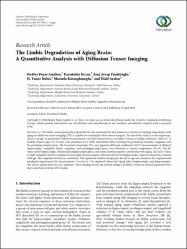The limbic degradation of aging brain: A quantitative analysis with diffusion tensor imaging

Göster/
Erişim
info:eu-repo/semantics/openAccessAttribution 3.0 Unportedhttps://creativecommons.org/licenses/by/3.0/Tarih
2014Yazar
Günbey, Hediye PınarErcan, Karabekir
Fındıkoğlu, Ayşe Serap
Bulut, Haci Taner
Karaoğlanoğlu, Mustafa
Arslan, Halil
Üst veri
Tüm öğe kaydını gösterKünye
Günbey, H. P., Ercan, K., Fındıkoğlu, A. S., Bulut, H. T., Karaoğlanoğlu, M. ve Arslan, H. (2014). The limbic degradation of aging brain: A quantitative analysis with diffusion tensor imaging. The Scientific World Journal, 2014. https://dx.doi.org/10.1155/2014/196513Özet
Introduction. The limbic system primarily responsible for our emotional life and memories is known to undergo degradation with aging and diffusion tensor imaging (DTI) is capable of revealing thewhite matter integrity. Theaimof this study is to investigate agerelated changes of quantitative diffusivity parameters and fiber characteristics on limbic system in healthy volunteers. Methods. 31 healthy subjects aged 25-70 years were examined at 1,5 TMR. Quantitative fiber tracking was performed of fornix, cingulum, and the parahippocampal gyrus. The fractional anisotropy (FA) and apparent diffusion coefficient (ADC) measurements of bilateral hippocampus, amygdala, fornix, cingulum, and parahippocampal gyrus were obtained as related components. Results. The FA values of left hippocampus, bilateral parahippocampal gyrus, and fornix showed negative correlations with aging. The ADC values of right amygdala and left cingulum interestingly showed negative relation and the left hippocampus represented positive relation with age. The cingulum showed no correlation. The significant relative changes per decade of age were found in the cingulum and parahippocampal gyrus FA measurements. Conclusion. Our approach shows that aging affects hippocampus, parahippocampus, and fornix significantly but not cingulum. These findings reveal age-related changes of limbic system in normal population that may contribute to future DTI studies.
WoS Q Kategorisi
Q2Scopus Q Kategorisi
Q2Kaynak
The Scientific World JournalCilt
2014Koleksiyonlar
- Makale Koleksiyonu [3811]
- PubMed İndeksli Yayınlar Koleksiyonu [4281]
- Scopus İndeksli Yayınlar Koleksiyonu [6648]
- WoS İndeksli Yayınlar Koleksiyonu [6722]


















